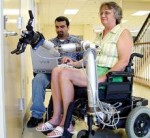Engineers develop a ‘helping hand’

As you read this article, engineers on campus are busy developing the next generation of prosthetics and rehabilitation tools. They will be highly interactive, allowing users to perform a broad range of normal actions, almost as if they’d never lost a limb.
USF is now on the cutting edge of technology in robotic prosthetics. Officials in the engineering department feel they’re about six months away from completing a project that will allow amputees to assimilate the proper use of their artificial limbs more efficiently.
Through virtual reality, this project is beginning to develop more sophisticated movements of new prosthetics, making them easier to use.
Working on this project is Stephanie Carey, fourth-year graduate student and Ph.D. candidate in Biomedical Engineering. She is part of the rehabilitation robotics group led by Dr. Rajiv Dubey, chair of the mechanical engineering department. This group is also working on a wheelchair-mounted robotic arm and other rehabilitation tools.
Carey described her field of research as “the compensatory motion of amputees that use myoelectric transradial prosthesis.”
In short, she is studying how to fit amputees with robotic prosthetic limbs that are controlled by the user’s muscles. Her research in prosthesis focuses on the wrist and forearm, though she said leg and knee prosthetics are also current subjects of study.
This research aims to develop a better method of the fitting of and acclimatization to a prosthetic limb. In a motion analysis laboratory, Carey said she is able to track and quantify body motions to determine how a person wearing a prosthetic limb has to move when doing common tasks. These can include drinking from a cup, opening a door, lifting a box or turning a steering wheel.
The purpose of the test is to see how prostheses must make up for the lack of wrist and forearm movement and compensate accordingly. The resulting data will help the researchers develop a computer model of a prosthetic arm and ultimately improve its design, fitting and training process.
Computer simulations will be developed from this data to help pair patients with the prosthetic limb that works best for them, Carey said. In virtual reality simulations, the patient can be accurately fitted with a prosthesis and learn how to operate it.
One of the most problematic phases of outfitting people with a prosthetic limb is the initial fitting and use, she said. Getting used to the movement and feel of the prosthesis while controlling it to perform everyday tasks can be a complicated and difficult job.
“It’s a lot of trial and error,” Carey said.
With this new process, a patient will be subjected to less stress while recovering from the loss of a limb. In addition to reducing the time needed to learn how to maneuver the prosthetic limb, this simulation technology will reduce the potential of injury due to the lack of adaptation to the prosthesis.
Some of the future applications of this technology might include neural control of robotic limbs, similar to the study conducted by the University of Pittsburgh in which they outfitted a monkey with a child-sized robotic arm. This arm was connected to its brain by thin electrodes and the monkey was able to use it to feed itself.
The field of robotic prosthetics will most likely continue its advancement in the development of more sophisticated software for computer modeling. This synergistic approach to rehabilitation is set to have a profound impact on those who have suffered from accidents and streamline the process of patients getting back to their lives.






